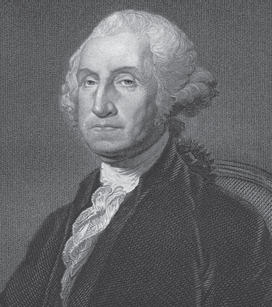George Washington (1732–1799) may have shaped the civic institutions and political culture of the United States more than any other Founding Father. He created what became the United States Army and led it to victory in the Revolution; he chaired the convention that wrote the Constitution in 1787; and, as the nation’s first president, he helped define the powers—and limits—of the office.

Washington was born into a wealthy family in Virginia. He worked as a surveyor, joined the Virginia militia in 1752, and fought on the British side during the French and Indian War (1754–1763).
Upon returning home from war, he married a wealthy widow, Martha Custis (1731–1802), and moved to Mount Vernon, his estate on the Potomac River. By now one of the wealthiest men in the colony, he was elected to Virginia’s legislature, in 1758. When fighting broke out, Washington was the only serious candidate for leading the Continental forces. He was commissioned by Congress on June 15, 1775—the date that marks the founding of the Continental Army, which became the US Army.
Thomas Jefferson (1743–1826), writing many years after the war, described Washington’s leadership style with admiration:
He was incapable of fear, meeting personal dangers with the calmest unconcern. Perhaps the strongest feature in his character was prudence, never acting until every circumstance, every consideration, was maturely weighed; refraining if he saw a doubt, but, when once decided, going through with his purpose, whatever obstacles opposed.
After the war, Washington stepped down from the army. He reluctantly agreed to serve as the first president and set important precedents for the new office. He refused monarchial-style titles, dressed in ordinary clothing, and served only two terms in office, setting the precedent that presidents should not serve for life.
He returned to Mount Vernon after leaving the presidency and died in 1799.
ADDITIONAL FACTS
- Many of the more fanciful myths surrounding Washington’s life were fabricated by Parson Weems (1759–1825), a nineteenth-century biographer. The Rappahannock River, which Weems claimed Washington threw a silver dollar across, is wide enough to make the story doubtful.
- George and Martha Washington did not have children of their own, but they raised two of Martha’s grandchildren from her first marriage, George Washington Parke Custis and Eleanor Parke Custis.
- Ironically, Washington was the only president who was never inaugurated in the city of Washington, DC, which was under construction for most of his presidency. His first inauguration, in 1789, was held in New York City, and his second, in 1793, took place in Philadelphia.
